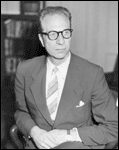 |
 Interpreting the Bible “is
an effort to go from a profound understanding of the livingness, the
fruitfulness, the vitality of the present Word of God behind, in,
through, under the text and to work with the written text in such a way
that it intersects each new time with its vitality and its truth” (Running
with the Hounds). With these words Joseph Sittler
enunciates his life-long work of intersecting “each new time” with the
power of Scripture. He respected scholarly approaches to the Bible, and
he utilized them at every turn. His top priority, however, was the
preaching and teaching of the Bible. The Bible carries the Word of God,
which Sittler understood to be “always a living encounter with the
awesome reality of God.” He often referred to the thought of philosopher
Paul Ricoeur, who said that “when a text becomes a written text, it
takes off and establishes a trajectory.” The most important thing about
the Bible is not what it meant in its original context, but what it can
mean today and in the future. He emphasized the “ductility” and
“evocative” character of language, particularly biblical language. His
goal was to be an agent of this evocative future-oriented trajectory of
the biblical message. Interpreting the Bible “is
an effort to go from a profound understanding of the livingness, the
fruitfulness, the vitality of the present Word of God behind, in,
through, under the text and to work with the written text in such a way
that it intersects each new time with its vitality and its truth” (Running
with the Hounds). With these words Joseph Sittler
enunciates his life-long work of intersecting “each new time” with the
power of Scripture. He respected scholarly approaches to the Bible, and
he utilized them at every turn. His top priority, however, was the
preaching and teaching of the Bible. The Bible carries the Word of God,
which Sittler understood to be “always a living encounter with the
awesome reality of God.” He often referred to the thought of philosopher
Paul Ricoeur, who said that “when a text becomes a written text, it
takes off and establishes a trajectory.” The most important thing about
the Bible is not what it meant in its original context, but what it can
mean today and in the future. He emphasized the “ductility” and
“evocative” character of language, particularly biblical language. His
goal was to be an agent of this evocative future-oriented trajectory of
the biblical message.
A sample of materials on Biblical
Interpretation
available from the Archives
-
“How to Read a Parable” (Published in The Care of the Earth,
Fortress Press Facets Edition, 2004), Book
-
Sermon on Romans VIII (Augustana Church,
Chicago), Audiotape (7/13, 20, 27/75)
|
 |
 |
 |

|
 |